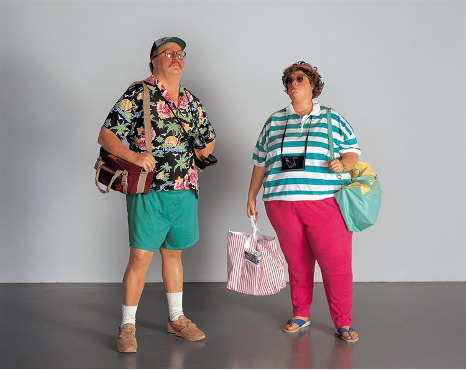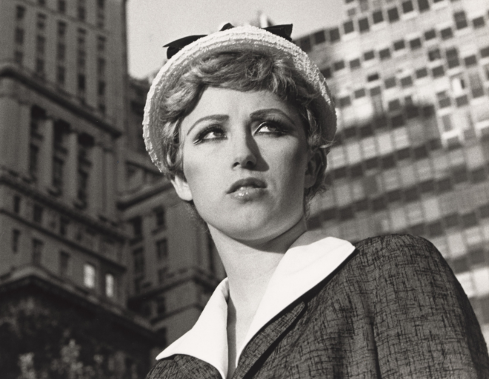Introduction
Work 1:

Duane Hanson’s “Tourists II,” 1988
Artist: Duane Hanson
Title: Tourists II
Date: 1988
Medium: Polyester resin, fiberglass, oil paint, clothing, and accessories
Dimensions: Approximately 72 x 42 x 42 inches (183 x 107 x 107 cm)
Stylistic Movement: Photorealism, Pop Art
Cultural Origin: American
Current Collection: The Museum of Modern Art, New York, USA
Work 2:

Cindy Sherman’s Untitled Film Still #21, 1978
Artist: Cindy Sherman
Title: Untitled Film Still #21
Date: 1978
Medium: Black and white photograph
Dimensions: 8 x 10 inches (20 x 25 cm)
Stylistic Movement: Appropriation, Conceptual Art
Cultural Origin: American
Current Collection: The Museum of Modern Art, New York, USA
Duane Hanson’s “Tourists II” and Cindy Sherman’s “Untitled Film Still #21” offer insightful commentary on their eras’ cultural and social identities through their depictions of persons and how they are portrayed in popular media. Both pieces question gender, class, and identity and mirror current cultural and societal challenges. Hanson and Sherman challenge the cultural narrative and give new perspectives on humanity by portraying characters in unusual ways. Hanson’s hyper-realistic sculptures and Sherman’s costume and role-playing in her images challenge representation and show how art can defy cultural narratives.
Social or Cultural Identity
Tourists II, 1988, by Duane Hanson, reflects the social and cultural identity of the post-World War II era in America. During this time, America underwent significant changes, including a rapid expansion of consumer culture and the rise of mass-produced goods. Hanson’s sculpture depicts a tourist as a symbol of this new American consumer culture, reflecting American society’s changing values and priorities at the time.
Cindy Sherman’s work, on the other hand, reflects the cultural identity of the late 20th century and early 21st century. During this time, there was a growing awareness of feminist issues and a challenge to traditional gender roles and expectations. In her self-portraits, Sherman challenges traditional notions of femininity and the representation of women in popular culture. By creating various personas and characters, she questions the authenticity of identity in an era characterized by mass-produced images and a proliferation of media.
Shaping of Social or Cultural Identities
Tourists II, 1988 by Duane Hanson and Cindy Sherman’s work have significantly influenced social and cultural identities. Hanson’s work critiques the post-World War II American consumer culture and highlights the impact of mass-produced goods on individual identity. This work continues to be relevant and serves as a reminder of the ongoing influence of consumer culture on modern society.
Cindy Sherman’s work has also significantly impacted the representation of women in popular culture. Her self-portraits challenge traditional gender roles and expectations, and her work continues to be a powerful statement on the representation of women in society. Sherman’s use of personas and characters has inspired a generation of artists and activists to question the authenticity of identity and representation.
Modern or Contemporary Expression
Tourists II, 1988, by Duane Hanson and Cindy Sherman’s work have significantly influenced modern and contemporary expressions of the shared theme of cultural identity and representation. Hanson’s work inspires artists who are critical of consumer culture and its impact on individual identity. For example, contemporary artists such as Jeff Koons and Damien Hirst have drawn upon Hanson’s work to explore similar themes. Contemporary artists such as Yasumasa Morimura and Mariko Mori have drawn upon Sherman’s work to explore similar themes. In this way, the works of Duane Hanson and Cindy Sherman continue to shape and inform contemporary expressions of the shared theme of cultural identity and representation.
Comparative analysis
Formal Characteristics:
Duane Hanson’s Tourists II, 1988, and Cindy Sherman’s art share formal traits. Both painters portray the human figure in realistic, emotional ways. Each artist uses different mediums and techniques. Tourists II, a lifelike fiberglass-reinforced polyester resin sculpture by Duane Hanson, invites viewers to stroll around and study it from numerous viewpoints. Cindy Sherman’s two-dimensional photographic self-portraits allow viewers to view the image as a single, fixed arrangement.
Influence of Traditions and Ideologies:
Duane Hanson and Cindy Sherman’s unique cultural traditions and philosophies have had a significant impact on their artwork. American artist Duane Hanson was active in the mid-to-late 20th century when mass production and consumerism were becoming increasingly pervasive in American culture. His work Tourists II, which features a tourist, a representation of the emerging American consumption culture, reflects this cultural context. The commercialization of American society and the resulting loss of originality and individuality can be read as a critique of Hanson’s work.
Contrarily, Cindy Sherman was influenced by the feminist movement and the notion of tearing down socially constructed gender stereotypes. She regularly utilizes herself as a model to produce photos that question conventional gender norms and expectations. Her work frequently examines how women are portrayed in popular culture and the media.
Representation of Social, Historical, and Cultural Climate:
Tourists II by Duane Hanson reflects the cultural and social milieu of the late twentieth century by focusing on consumerism and commercialization in American society. The artwork is a commentary on the decline in authenticity and originality in American society and features a tourist, a representative of the modern American consumer culture.
Similar to this, Cindy Sherman’s art captures the social and cultural context of the time by questioning conventional gender norms and expectations and examining how women are portrayed in popular culture and the media. The photos she produces make a strong statement about the ongoing fight for gender equality as well as a critique of how women are objectified and sexualized in modern culture.
Parallels:
Chris Ofili’s work, The Holy Virgin Mary, shares several parallels with the works of Duane Hanson and Cindy Sherman in terms of historical themes and settings. Like Hanson and Sherman, Ofili addresses the theme of cultural identity and the representation of women in contemporary society.
In The Holy Virgin Mary, Ofili presents a unique take on the traditional representation of the Virgin Mary in Western art by using vibrant colors, glitter, and elephant dung, which was a departure from traditional depictions of religious figures in art. In this way, he critiques the way in which religious figures have been used to perpetuate patriarchal structures in society and addresses the theme of cultural identity and representation.
Relevance:
The historical themes addressed in the works of Duane Hanson, Cindy Sherman, and Chris Ofili are still highly relevant today, and their art continues to offer a powerful commentary on contemporary society. The representation of women in popular culture, religion, and the media continues to be a topic of ongoing discussion, with issues such as the sexualization of women and the perpetuation of patriarchal structures still being addressed in contemporary art and activism.
The Holy Virgin Mary is a particularly relevant work in this regard, as it highlights the ongoing struggle to represent women in a positive and empowering light. The use of vibrant colors and unconventional materials in this work serves as a powerful statement on the importance of challenging traditional representations of women and rethinking cultural norms. In this sense, Ofili’s work is not only a powerful critique of patriarchal structures but also offers a vision of a more inclusive and diverse society.
Conclusion
The comparative analysis of Duane Hanson’s Tourists II, 1988, and Cindy Sherman’s work highlights the relevance and value of the perceived notion of the artist’s responsibility to society and the impact of these works of art on modern and contemporary culture and practice. Both works explore similar themes, reflecting the social and cultural identities of their respective eras. Furthermore, they have had an influence on the modern and contemporary expression of the shared theme. By examining the visual and historical aspects of each artwork, this analysis has demonstrated how both works have been influential in shaping modern and contemporary ideas of identity, gender roles, and the notion of the artist’s responsibility to society.
References
Bronfen, E. (2021). The Other Self of the Imagination: Cindy Sherman’s Hysterical Performance. In Hysterical Methodologies in the Arts: Rising in Revolt (pp. 179-202). Cham: Springer International Publishing.
Russell, J. (2020). The meanings of modern art. Routledge.
Stallabrass, J. (2020). Contemporary art: a very short introduction (Vol. 146). Oxford University Press, USA.
Toama, Q. Z. (2019). Body Language in the Works of Sculptors George Segal and Duane Hanson. Al-Academy, (91).
 write
write